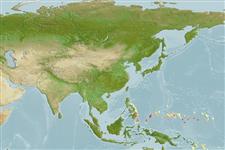>
Gobiiformes (Gobies) >
Gobiidae (Gobies) > Gobiinae
Etymology: dabra: Named for David Winterbottom and Bradley Hubley, an arbitrary combination of letters, 'dabra'..
More on author: Winterbottom.
Environment: milieu / climate zone / depth range / distribution range
Ecologia
marinhas associadas(os) a recifes; intervalo de profundidade 0 - 24 m (Ref. 55341). Tropical
Western Pacific: currently known only from Palau.
Tamanho / Peso / Idade
Maturity: Lm ? range ? - ? cm
Max length : 1.9 cm SL macho/indeterminado; (Ref. 55341); 1.8 cm SL (female)
Espinhos dorsais (total): 6 - 7; Raios dorsais (total): 7-10; Espinhos anais 1; Raios anais : 7 - 9. Distinguished from its congeners in having a strong dark bar on the body, beginning just anterior to the origin of the first dorsal fin and passing ventrally just behind the base of the pectoral fin; about equal in width to the eye diameter. It has a dark anteroventrally-directed wedge-shaped bar from the eye to the jaws; a similar, but better developed postero-ventrally-directed bar from the eye to the vicinity of the vertical limb of the preopercle; a small dark blotch spot or bar on the anteroventral margin of the opercle. There is a black blotch at the middle length of the upper pectoral fin rays (Ref. 55341).
Ciclo de vida ou comportamento de acasalamento
Maturidade | Reprodução | Desova | Ovos | Fecundidade | Larvas
Winterbottom, R., 2005. Feia dabra, a new species of gobiid fish Acanthopterygii: Perciformes) from Palau. aqua, J. Ichthyol. Aquat. Biol. 10(2):45-50. (Ref. 55341)
Status na Lista Vermelha da UICN (Ref. 130435)
Ameaça para os humanos
Harmless
Uso pelos humanos
Mais informação
Nomes comunsSinônimosMetabolismoPredadoresEcotoxicologiaReproduçãoMaturidadeDesovaAgregação de desovaFecundidadeOvosDesenvolvimento dos ovos
ReferênciasAquaculturaPerfil para aquaculturaEstirpesGenéticaElectrophoresesHereditariedadeDoençasProcessamentoNutrientsConversão de massa
ColaboradoresFotosStamps, Coins Misc.SonsCiguateraVelocidadeTipo de nataçãoÁrea branquialOtólitosCérebrosVisão
Ferramentas
Relatórios especiais
Baixar XML
Fontes da internet
Estimates based on models
Preferred temperature (Ref.
123201): 28.8 - 29.4, mean 29 °C (based on 150 cells).
Índice de diversidade filogenética (Ref.
82804): PD
50 = 0.5625 [Uniqueness, from 0.5 = low to 2.0 = high].
Bayesian length-weight: a=0.01023 (0.00477 - 0.02194), b=3.02 (2.84 - 3.20), in cm total length, based on LWR estimates for this (Sub)family-body shape (Ref.
93245).
Nível Trófico (Ref.
69278): 3.0 ±0.3 se; based on size and trophs of closest relatives
Resiliência (Ref.
120179): Elevada, tempo mínimo de duplicação da população menor que 15 meses (Preliminary K or Fecundity.).
Fishing Vulnerability (Ref.
59153): Low vulnerability (10 of 100).
